#arabian folktale
Text
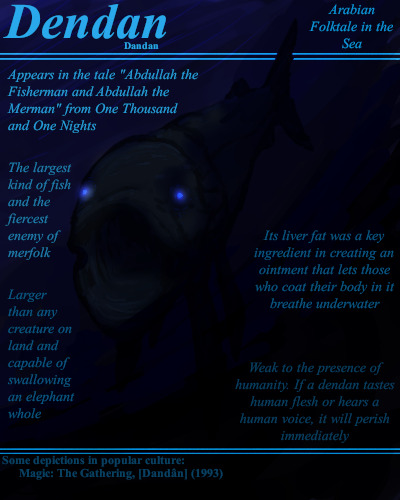
Humanity need not fear the biggest fish, for it knows them and fears them.
#BriefBestiary#bestiary#digital art#fantasy#folklore#legend#folktale#arabian folktale#arabian folklore#sea monster#dendan#dandan#one thousand and one nights#abdullah the fisherman and abdullah the merman#arabian nights
34 notes
·
View notes
Text

Léon Georges Jean-Baptiste Carré (1878 ~ 1942) 1926 illustration for 'The Book of One Thousand and One Nights'
#Léon Georges Jean-Baptiste Carré#Léon Carré#The Book of One Thousand and One Nights#Leon Carre#One Thousand and One Nights#Arabian Nights#1920s#Middle Eastern folktales#Middle Eastern fairy tales#folktales#fairy tales#fairytale#fantasy#folklore#fairy tale illustration#vintage art#vintage illustration
113 notes
·
View notes
Text

THE ARABIAN NIGHTS’ ENTERTAINMENT revised for young readers with notes by George Fyler Townsend (London/New York: Frederick Warne, c.1894). Illustrated with b/w and color plates.
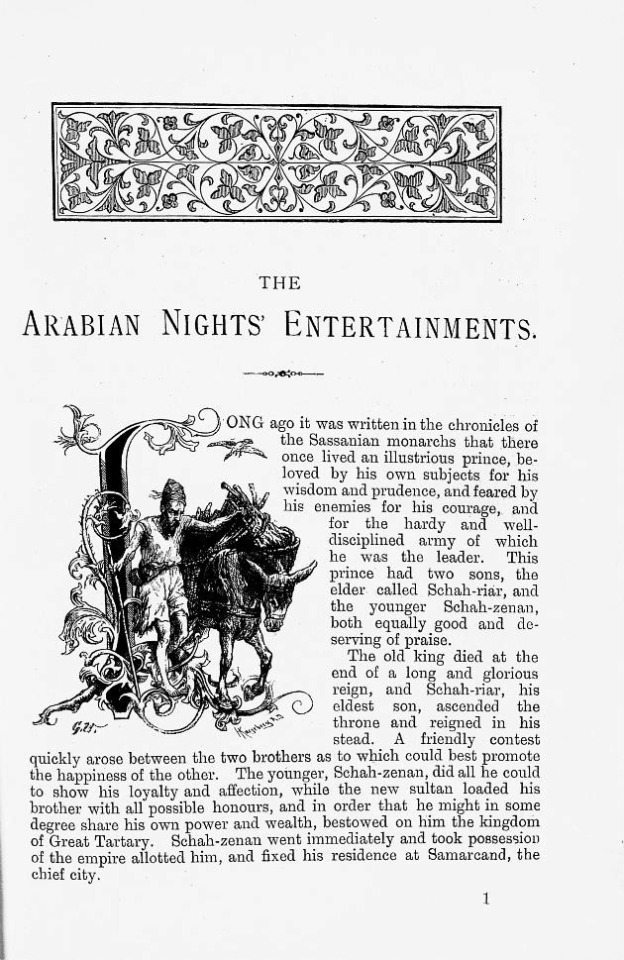


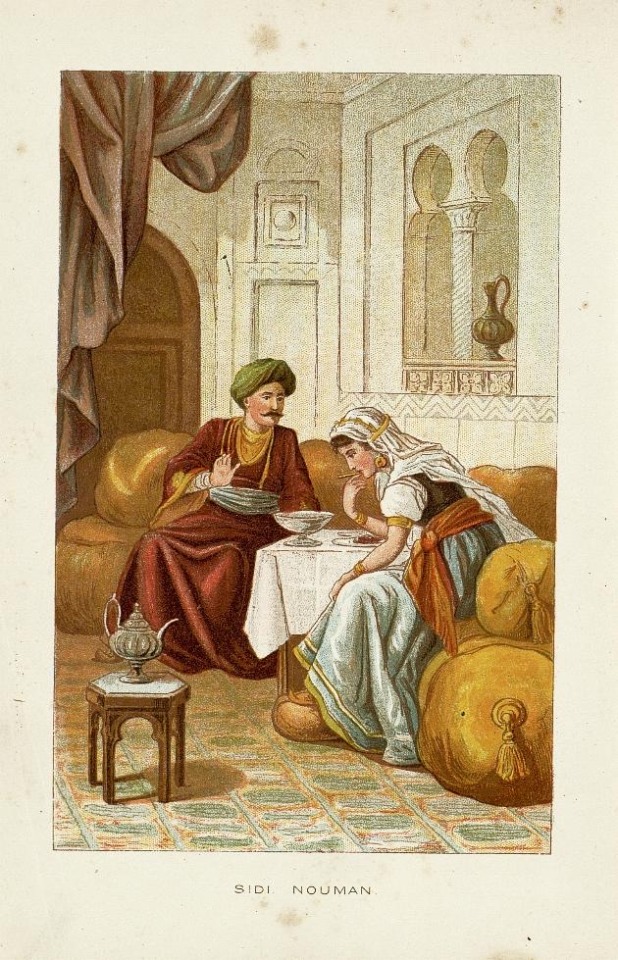
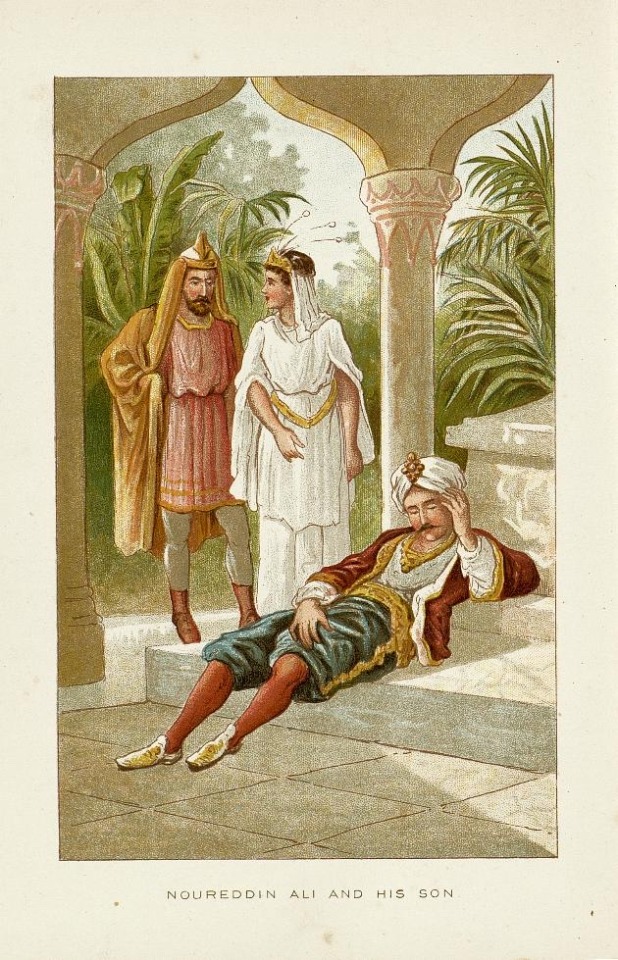
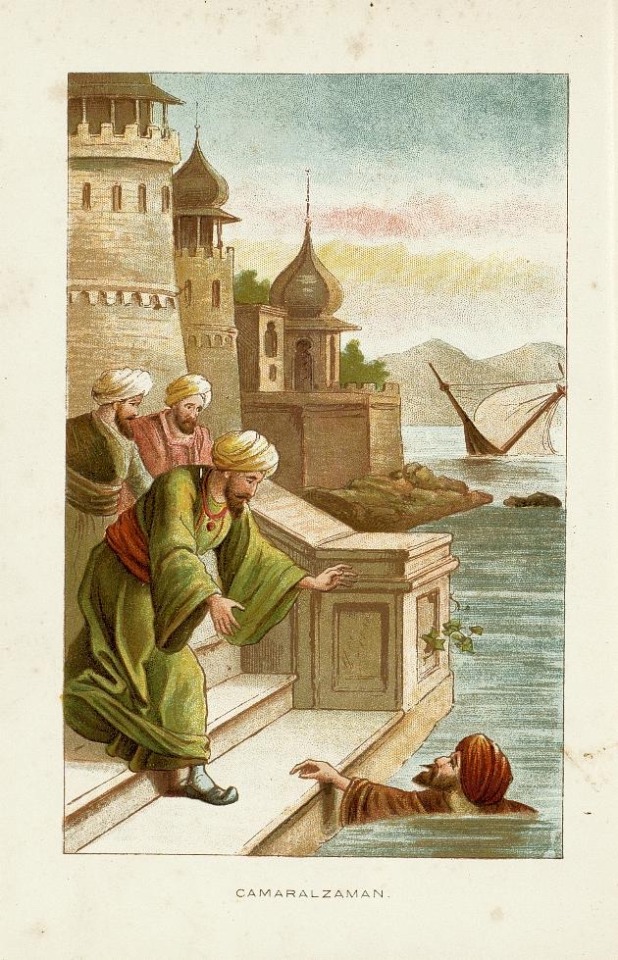


#beautiful books#book blog#books books books#book cover#books#vintage books#illustrated book#victorian era#children’s book#book design#arabian nights#simbad#folktales
36 notes
·
View notes
Text
Fairy Tale - short story usually that is part of folklore/folktales . But did you know the most famous take of them, the German tales we've all come to hear & love, aren't exactly fairy tales? But really, they're considered "Wonder tales" or, tales of wonder.
Among the oldest that we can trace are some that come from South Asia and the Middle East, the exact origin/time frame is unknown as they have a history of existing first as oral tales in verse/poetic form that were later written down, then translated again into prose.
But the point of these folk tales were to elicit a sense of wonder - that they did!
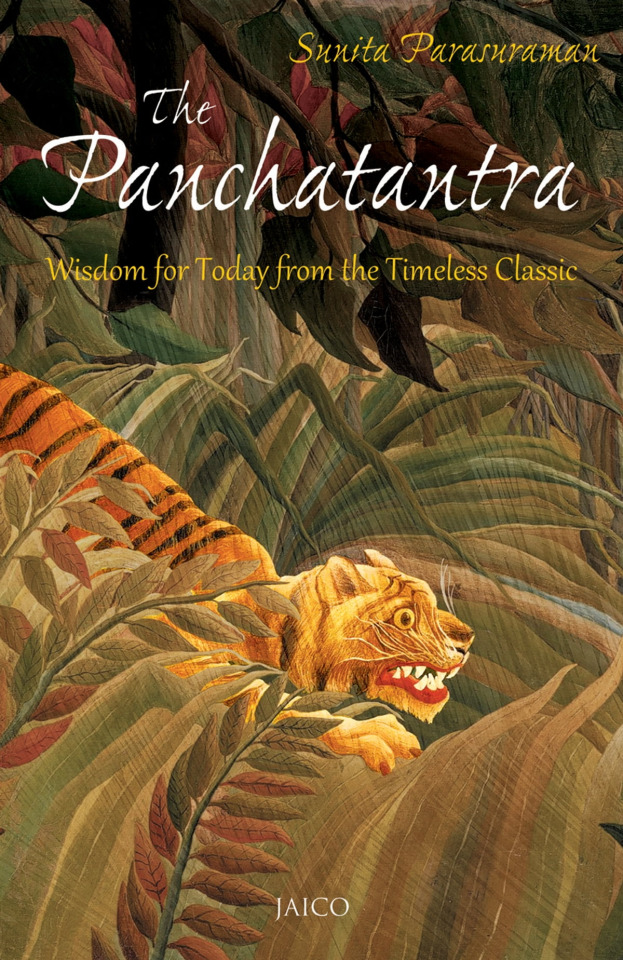
The Panchatantra is an ancient collection of interrelated animal fables written in Sanskrit. It varies from story to story in prose format as well as verse all within a frame story.
The earliest known translation of it in a Non Indian language dates to 550 CE and is translated into Middle Persian.
Many of the fables within also share and discuss life lessons, morality, and things to contemplate beyond the wondrous stories themselves.
There are lessons to take away, as well as, for those interested in shared/comparative mythology/storytelling, beats and similar tropes/takes of tales you might recognize 🤔
Some examples can be the snake and the mongoose story, which later likely served as inspiration for Rudyard Kipling's Rikki-Tikki-Tavi.
And while considering the history and travel/trade of stories and their evolution (something Tales of Tremaine is about), here's something to consider:
"Sanskrit literature is very rich in fables and stories; no other literature can vie with it in that respect; nay, it is extremely likely that fables, in particular animal fables, had their principal source in India." — Max Muller, On the Migration of Fables
Now, something ELSE you MUST take into account in this is how stories travel and originate. Most are for a mix of reasons, and you can't take out PIE (proto indo european) influences, then the silk road/trade migration, as well as storytelling structures once taught take on their own lives. Every culture has animals, so the motifs, tropes, beats, are going to be taken and then reapplied to a local culture.
Many scholars have noted and commented on the strong similarity between some of the stories in the Panchatantra and Aesop's Fables. And so the Panchatantra has come to be held by many as the source or most prominent source of many of the fairy/wonder tales content/structure/shape we've come to know today.
Vijay Bedekar in the History of the Migration of the Panchatantra has noted that origin of several of the stories in Arabian Nights, Sinbad, and 30-50% of western nursery rhymes and ballads have their origins in the Panchatantra as well as the Jataka tales (another collection of folk stories, about Buddha and many lives/forms/incarnations.
Many Jatakas are told with a common threefold plot schema which contains a “narrative in the present” | paccupannavatthu |, with the Buddha and other figures, a “narrative in the past” |atītavatthu|, a story from a past life of the Buddha, a "link" |samodhāna| in which there is an “identification of the past protagonists with the present ones.
If that seems familiar, it's because you'll see this sort of played out as well in Tales of Tremaine through items/characters - timeline.
But, how did this come to travel so far and wide? Wheeeeellllllllllllllll. Do you remember Nalanda, and how far it drew students from as the oldest residential university, catering to students interested from afar most especially in Buddhism?
Whaaaaale. That's how. The records we have indicate that Buddhist monks traveling along brought copies of the texts, along with other Sanskrit texts to: Tibet, China, Mongolia, and all throughout South East Asia where Buddhism can be found.
One of the earliest stories of panaceas and life saving magical herbs spread from South Asian stories. One early record of this which has now become a trope is found in the 10 century in where a Persian physician read about an herb that could restore a dead man to life and wished to find it with his king's blessing.
Narrator: He did not find the herb.
Anyways, after spreading to the Middle East, the Arabic translation of this collection was later translated to Greek then Spanish - old Castilian, and then into Hebrew by Rabbi Joel in the 12th century. Then Latin.
Anyways, Forest Gump voice: that's all i have to say about that (not really but for now).
#folktale#folklore#folktales#German tales#fairy tales#fairy tale retelling#animal fables#fables#translation#translated literature#lore#magic#buddhism#arabian nights#sinbad#panchatantratales#panchatantra#aesops fables#sanskrit#literature#literary history#literary analysis#r.r. virdi#rrvidri#Persia#asia#middle east#rikki tikki tavi#rudyard kipling
3 notes
·
View notes
Text
*The Tale of Tsar Saltan, of His Son the Renowned and Mighty Bogatyr Prince Gvidon Saltanovich, and of the Beautiful Princess-Swan
My tag for this series is 'fairy tales'.
#polls#fairy tales#folktales#the emperor's new clothes#the story of the princess arab zandiq#beauty and the beast#aladdin and the wonderful lamp#aladdin#arabian nights#the magic mill#the king of cats#the tale of tsar saltan#the great race#diamonds and toads#toads and diamonds
22 notes
·
View notes
Text



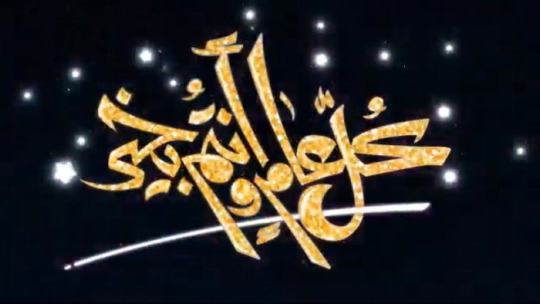
#Asatir#Asatir: Future Folktales#Future Folktales#Saudi Japanese animation#'Eid#حلاوة بقر و النظارات و اللي مثل بيز لكن حامضة و كل الألوان... xD#text reads: kul 'am wa antum bikhair (may you be in good health every year) and is often a greeting/well wish on 'Eid ^^#henna#hands *#faceless *#sweets *#food *#traditional Arabian clothing#for the thobe bisht and ‘iqal and such#unsure about the mother’s clothes since there’s some western influence in a lot of older dresses too but I don’t know enough#the gold and white makes me THINK of certain dresses from Makkah and Madinah#but too simply drawn and I lack the deeper knowledge of traditional dresses in the Arabian gulf#it doesn’t help that women’s clothes like that are worn in the privacy of the home so I’d know even less#you don’t see them in the streets!
8 notes
·
View notes
Text

Folktale Week Day 1: Fool
Hi, everyone! This challenge is much more active on Instagram, but going to drop a few images here as well since my Tumblr is feeling sadly neglected! To learn more about Folktale Week as a whole, visit: https://www.instagram.com/folktaleweek/
This illustration was inspired by one of my favorite stories from 1001 Nights, The Caliph and the Merchant, specifically from the story cycle The Adventures of the Caliph Haroun Alraschid. (If you've seen the 2000 miniseries adaptation, you'll know this story as The Sultan and the Beggar, in which the Sultan gets a darker role and comes to a darker end). In this tale, the caliph, bored with his routine at the palace, decides to wander the streets of Bagdad in search of amusement. He meets Abon Hassan, a local merchant, and Abon invites him home for supper. Not knowing who his guest really is, Abon starts talking about how he would run the city if he were caliph, and Haroun Alraschid thinks it would be fun to give the merchant a shot at it. So he drugs Abon and then has his servants carry the man to the palace. The next morning, Abon wakes up in the royal bed, surrounded by servants and slaves who tell him he is the caliph. At first the merchant argues, but eventually he decides to enjoy his good luck. The story has its cruel points; when Abon wakes up the next day in his own bed, his ravings get him chained to a wall in the madhouse. Still convinced it’s all a game, the caliph later repeats the trick.
Though the Caliph plays Abon for a fool, Abon manages to get back at him. And though Abon is treated throughout most of the story like a pawn in the Caliph's game, this doesn't overcome Abon’s excitement over being king for a day. Often the moral of fool stories is that having a little fun is the best kind of payback.
#arabian nights#1001 nights#african elephant#children's illustration#artists on tumblr#illustration art#illustrators on tumblr#folktale#folktale art#fairy tale art#fantasy illustration
16 notes
·
View notes
Text
Question: if the TS Cast existed in the real world, what nationality do you think they’d be?
This is my headcanon:
*A lot of it is based off of food they like 💀💀💀 but bare with me. This idea has been brewing in my mind a lot and I gotta get it out there.
Ais: Japanese. I think this is the most obvious one. The Shinto gates, the red oni horns, he drinks green tea, the yukata he wears. Also there’s a possibility that Ocudeus was inspired by the ancient Japanese kraken called Akkorokamui of Ainu, but that’s just my prediction. I also see him as a Wasian. Maybe I’m projecting my biracialness hehe.
(More under the cut)
Leander: German. This one I’m a little “???” on but he’s a heavy drinker and I know beer is an iconic beverage in Germany. Legal drinking age is also 14 with adult supervision. Also according to this by the amazing @eridiasangel, Leander likes hashbrowns, and potato is a staple food in Germany. Then there’s the magic flowers symbolism and it reminds of the movie Tangled inspired by the German folktale.
Kuras: Egyptian or Iraqi! I’m basing this off his design choice, but also Eridia is heavily inspired from Arabian/Islamic architecture so if we assume Kuras was the “founding father” of Eridia, than I think it’s safe to assume he is of that descent irl. There’s also the House of Knowledge in Egypt and House of Wisdom in Baghdad so it fits him perfectly.
Edit: thanks to anon who informed me Arabian is actually an ethnolinguistic group!! 👍
Mhin: Chinese. I’m basing this off of this TS post. Many people think it’s the Chinese food, Tang Yuan. Other than that I’m kinda 🧍♀️on this one. I could also see them being European cuz they give gothic, Victorian vibes.
Edit: also their name reminds me of the Chinese name, Min, which means “quick” and “clever”
Vere: I am really stuck on Vere, but I have to say Filipino maybe Taiwanese cuz it’s canon he likes Fruit Oolong Tea.
What do you guys think? Do you agree or have another nationality in mind for them?
181 notes
·
View notes
Text
Wassup fam, I've been researching a lot recently. Have my fav jttw guy meet my fav arabian folktales guy. I wish there was more art of literary crossovers

They're so cute and I love them
Holds them gently


#Tripitaka#Tang Sanzang#journey to the west#Sindbad#Arabian Nights#artists on tumblr#Sketches#illustration#character art#character design#chinese mythology#platonic#not a ship#theyre literally both religious#lego monkie kid#i guess#lmk fanart#jttw
39 notes
·
View notes
Note
It might be cool to see dullahan for pride month. I don't think any original stories about dullahan are particularly queer but her depiction SMTIV is something I think about a lot. Taking a red pill and changing gender is definitely a more accurate interpretation of the matrix than other times people talk about the red pill at least lol
Dullahan - Day 49 (Request)
Race: Haunt
Alignment: Neutral-Neutral
June 6th, 2024

Yeah, shoutout to the random NPC in SMT IV who eats a red and instantly transes their gender. A true icon. Today's Demon of the Day is a very common fixture of medieval fantasy, however, and not just a bit of someone's true identity- the headless knight of no renown, Dullahan. Headless Horsemen are a common sight in many tales spanning Europe, the subjects of many a legend or fairy tale, but each of these halloween fables can trace their roots all the way back to Celtic myth, in the form of this unseelie fairie... or so some think. In truth, the origins of the Dullahan are unclear and murky, much like the foggy skies it mingles within, so let's dig in!
Ireland is no stranger to weird fairy tales- as the place where the term fairy originated from, Celtic myth is filled with tales upon tales of weird, loveable goons that paint stranger and stranger pictures of the times each time one thinks about them. Whether it be the oh-so-elusive Cat-Síth or the inanely wailing Banshee, Celtic folktales are filled to the brim with creatures at the forefront of each and every story... which is what makes the Dullahan so bizarre. While the concept of a headless horse-riding knight isn't too out there, especially in comparison to some other fairies (looking at you, Pooka), very few primary sources actually attest to the existence of the Dullahan, whether it be by name or concept alike.
However, in spite of this, we do have a few historical accounts- this makes the Dullahan's existence frustratingly vague, to say the least, as it's impossible to say if it did or did not exist- either possibility is plausible, especially given that artwork depicting the Dullahan does exist, dating back to the 1800's. As according to Doris V. Sutherland, the earliest reference to the Dullahan can be found in 1802, within a text written by Charles Vallancey called "Prospectus of a Dictionary of the Language of the Aire Coti, or Ancient Irish, Compared with the Language of the Cuti, or Ancient Persians, with the Hindoostanee, the Arabic, and Chaldean Languages." Kind of a mouthful. Within the book, which is a compendium of all sorts of languages and drawn comparisons between them (among all sorts of other stuff, I'm too lazy to find a free copy of it online though lol), there is a segment in which Vallancey draws a comparison between the Irish Dullahan and an Arabian demon, the Wulahan.
"The Dullahan or Wullahan is a terrible bug-bear at this day; the peasants hear him in the night dragging a heavy chain through the villages and along the roads; this is the wulahan, or Satanas of the Arabs…"
As pointed out by Sutherland, though, the brief description given of only a few passages has no mention of it being headless. So why is it commonly seen as being headless? Skip ahead a few years and we get to a book by Thomas Cofton Croker going into the fairies of Irish folklore, and stories pertaining to them. Among the many fairies listed in this book, entitled "Fairy Legends and Traditions of the South of Ireland," we get to our second mention of the Dullahan! In one of five segments, a tale is given regarding a man named Larry Dodd who gets a random hitchhiker one day atop horseback- a mysterious woman whose every feature was covered by a cloak. She climbs aboard after he offers so, and they take off.
After a few moments of silent, uncomfortable riding, the woman exits suddenly to head to a nearby church. Smitten, Larry chases after the woman to try and pursue a thank-you kiss, but when he catches up with her... shock! Horror! She has no head! So that's where the idea of the Dullahan came from as being headless- and likely why the Dullahan in SMT is so feminine in appearance as well. After witnessing a dance of the Dullahans in the dead of night, he's decapitated... only to come to a few hours later, confused from the whole sordid affair.
This tale is only one of four, however- the general idea of Dullahans and the Headless Horsemen being synonymous actually came from this same book as well. A later story is, well, quite literally the fable of the Headless Horseman! From these tales, we can glean quite a few things- almost every account of the Dullahan comes from this book, with the name being spurned from the Prospectus and its offhand mentioning of the 'Irish Dullahan' as though it were common knowledge. I'm of two minds here, personally- for one, it's entirely possible that Croker, pardon my french, just made some shit up, basing his fables on pure speculation as to what the Dullahan name could mean by connecting it to the Arabian Wulahan. However, the other possibility, one that I personally subscribe to, is that the Dullahan was a part of the tapestry of Celtic folklore- it was just obscure.
The tales presented clearly speak of the Dullahan as though it were a preexisting concept, and the offhand mention of its existence in the Prospectus seems to give light to the idea that it did, indeed, exist in the cultural consciousness to some extent. Of course, this is all purely guesswork on my end- unless Croker digs himself out of his grave to answer my burning questions, I doubt I'll find an exact answer to this line of thinking- but I think it makes the most sense given what little information we have to work off of.
Now, in terms of representation in SMT... It sure is a headless knight. One aspect I really adore in this design, though, has to be the way the top of the head appears- the implication of the Dullahan being able to freely attach and detach its head like the joints on a Bionicle is hilarious, and gives a whole new line of depth to this already cool looking design. The silver, deep purple, and gold all combine to make the knight look regal, as though it was a stalwart protector of a kingdom under the king's right hand that had now fallen into disrepair. Somewhat fitting, given that it appears most prominently in SMT IV as a boss!
Lastly, though, I've gotta say I'm so glad we're almost to 50 posts. I didn't expect this series to last this long, and we've got a big, big one coming up for post 50, so I hope you're all excited! Happy Pride Month, and I need to say thanks for sticking with me, all this time.
#smt#shin megami tensei#megaten#persona#daily#ask#dullahan#the fact that my primary source for this one was another trans person is not lost on me lmao#esp given that the npc eating the red is very#VERY. trans coded#all that aside#holy shit#we're almost at 50 posts!!!#the next one is gonna be a biiiig one#i hope y'all will look forward to a big ol' bug
11 notes
·
View notes
Text
Natsume, Mamiya, and the Arabian Nights
During MAMIYA's EX route, Natsume mentions a number of different books he spectates in his quest to find Mamiya, but there is only one story he mentions by name.
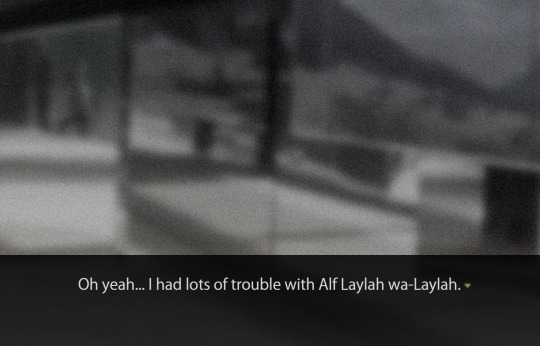
Oh yeah... I had lots of trouble with Alf Laylah wa-Laylah. After all, the man showed up in every nightly story of Scheherazade. I saw him in Sinbad's shadow, behind Alibaba, within Aladdin's smoke... Whether the king decapitated [the maiden]* or not didn't matter...
Alf Laylah wa-Laylah is the original Arabic name for the story known in English as One Thousand and One Nights, also known as Arabian Nights. It's a collection of folktales told within the framing device of another story: the tale of the king Shahryar and the woman he marries, Scheherazade.
As the tale goes, King Shahryar learns that his wife is cheating on him, and after having her executed, he resolves that he will marry a new virgin bride every day and then have her beheaded the following morning so she won't have a chance to be unfaithful to him. After three years of marrying and killing brides, the only young women left in the city are his vizier's daughters, the older being named Scheherazade. Scheherazade volunteers to marry the king, but before they head off to their marriage bed, she says she wants to say goodbye to her sister. The king permits this, and when Scheherazade's sister comes to their room, she asks Scheherazade to tell her a bedtime story. Unbeknownst to the king, Scheherazade had instructed her to do this, and Scheherazade begins telling a story that leaves both her sister and her new husband entranced.
However, Scheherazade stops halfway through the story, saying that she will continue her tale the next day. Wanting to hear the end of the story, King Shahryar decides not to execute her, and the next night, Scheherazade finishes her story. Then, she begins a new story, but she leaves this one half unfinished too, forcing the king to keep her alive for another day. The same thing happens the next night, and the night after that—and by this method, Scheherazade manages to postpone her death by 1001 nights.
Saving yourself from being killed by telling stories, huh? Hm, that sure sounds familiar...

This post is an analysis of the parallels between 1001 Nights and MAMIYA EX. Word count: 3.7k
(Spoilers for the entire game!)
*Important note: The game translates 「王が娘���首を撥ね(る)」 as "the king decapitated his daughter," but I believe this to be a slight mistranslation. I believe that the phrase is meant to be describing Scheherazade, in which case it should be translated as "the king decapitated the maiden." This is further backed up by 1001 Nights itself, which explicitly states that the method that Shahryar used to execute his wives was decapitation. [EDIT: It's been corrected! Thanks Fruitbat.]
One Thousand and One Nights Abridged
The summary of 1001 Nights I gave before was pretty short, but I'm going to summarize it again in a little more detail so I can refer to it in other sections. I relied mostly on this version of 1001 Nights, which is the English translation of a French translation. I believe it is lightly censored from the original Arabic text (or things were lost in translation), but it is very readable. The English translation by Sir Burton is an unabridged and uncensored translation of the Arabic text, but that means it also inherits the worst part about the original text: no paragraph breaks, which makes this version a lot harder to parse.
King Shahryar discovers that both his brother's wife and his own wife have been cheating on them. He also meets the wife of a powerful jinn who coerces Shahryar and his brother to sleep with her, and from these experiences he decides that all women are unfaithful. After having both his sister-in-law and his wife beheaded, Shahryar orders his vizier to bring him a new virgin bride every night. He marries these women, deflowers them, and then proceeds to execute them by decapitation the next morning before they are able to cheat on him.
Of course, Shahryar's actions quickly deplete the population of young women in the city as the unlucky ones are executed and the lucky ones flee with their families. At the end of the three years, the only eligible brides left are the vizier's own two daughters: Scheherazade and Dunyazad. Scheherazade is a well-learned, well-read woman, and when she sees her father upset about not being able to find any more brides, she tells her father to marry her off to the king, wanting to spare other women from the same fate. The vizier, of course, protests, but she is adamant, and the wedding happens.
On their wedding night, Scheherazade pretends to cry, and when Shahryar asks her what's wrong, she says she would like to say goodbye to her sister Dunyazad. Unbeknownst to him, she had instructed Dunyazad to ask Scheherazade to tell her a story. Dunyazad comes in and asks for a story, and Scheherazade spins her tale, and both her sister and her husband are mesmerized by her storytelling. But at the midpoint of the story she stops, as morning is approaching. Shahryar, captivated by her storytelling, wants to hear the end of the tale, and decides not to kill her that morning. The next night, Scheherazade finishes the story, and then starts telling another one. Again, she stops halfway through this story. Shahryar, wanting to hear the end of this story, lets her live another day, and so on and so forth.
Some of the more famous stories she tells include "Aladdin and the Wonderful Lamp," "Ali Baba and the Forty Thieves," and "The Seven Voyages of Sinbad the Sailor." The stories continue for 1000 tales and 1001 nights (about 2 years and 9 months), at which point Scheherazade runs out of material. Before the day breaks, she asks to see the three children she had borne the king one last time before her execution—but the king spares her life. After 1001 nights of being with her, Shahryar has fallen completely in love with Scheherazade, and he makes her his queen.
In all of MAMIYA EX, 1001 Nights is the only story that is explicitly named, and I believe this to be intentional on KokoroTen's part. There are, in fact, a lot of parallels apparent between the tale of Shahryar and Scheherazade and what happens on Natsume and Mamiya's Fun Desert Vacation. Yeah that's right that means Natsume and Mamiya are married
Three Thousand Years and a Thousand Nights Story: Mamiya as Scheherazade

Semi-related VOCALOID listening: link
The thing about the Mamiya who travels the desert with Natsume is that he's not special. He's not different from any of the other Mamiya fingerprints whom Natsume hunts down. The only thing that separates this fingerprint from all the other ones is that he was in the right place at the right time, and this allowed him to strike up a deal with Natsume: his life and Natsume's acceptance in exchange for becoming Natsume's storyteller.
I find it interesting Mamiya specifies that he will memorize every line of Natsume's book, as opposed to reading off the book (as at this point, they do still have the book with them). Of course, this serves to dehumanize this fingerprint as he transforms from his own self into being Natsume's personal object, but it also draws parallels to Scheherazade. If you recall, Scheherazade recited her stories from memory, too, and thus like her, it is only Mamiya's ability to remember tales and recall them that allows this fingerprint to live. In both cases, this remembrance is directly tied to protection and preservation—for Scheherazade, for Mamiya, and for Natsume's story as well, as Mamiya's memorization of his book is a means of rendering his story immortal.
Another similarity to Scheherazade is that Mamiya isn't just any storyteller, he acts as Natsume's bedtime storyteller. While there are many ways to tell a story—bards and their music come to mind—bedtime stories soothe the soul and help people fall asleep, which is very apparent in Natsume and Mamiya's case. Most importantly, though, bedtime stories are intimate, usually being told to only a single or a few children at a time. Storytime before bed is a very personal act that builds relationships (typically between a parent and child, and wouldn't you know it, Mamiya does compare Natsume to a baby at one point). 1001 Nights even mentions that on the first night, the King and Scheherazade "passed the rest of the night in each other's arms," which is more or less what Natsume and Mamiya are doing in that one CG. You know the one. This one:

Censored for indecency (touching above the waist), sorry.
Oh, it's also notable that Scheherazade has a sister! Although the focus of this analysis is on EX, it felt relevant to point out given how this parallels Mamiya more or less having a sister in Mina. Another thing that's outside the scope of this analysis is the frequent feminine imagery associated with Mamiya, but, you know, that's there too. Pink House calls him "the mother" during the cannibalism scene, so maybe that's foreshadowing for EX Mamiya giving birth to three of Natsume's children?
There are differences between Mamiya and Scheherazade, of course. I'd say that thematically, the major one is their motivations for being with their partners. In 1001 Nights, Scheherazade's motives for marrying the king are entirely selfless; when she sees her father, the vizier, in despair over being unable to find a new bride for the king, she offers herself, saying that she will either live, or she will die saving another girl from death by the King.
On the other hand, Mamiya's motives seem more selfish—this particular fingerprint is able to ensure his survival, and is even given that much-craved acceptance from Natsume, but it's at the cost of the other fingerprints. Mamiya stands back and allows Natsume to murder his other selves, doesn't lift a finger to stop it (although it's made abundantly clear that there's not a lot he could do). In fact, it's really only because Mamiya made that deal with him at all that Natsume didn't lose the will to live, escapes to the desert, and is able to continue with his Mamiya murders.

This selfishness is observed again, in all its fragility, with the answer he gives to Natsume's declaration of protection, as shown in the dialogue above. Where Scheherazade was defined by a duty to the people to prevent further injustice alongside self-preservation, Mamiya is defined by the desire to be explicitly needed (more on that in the next section).
Speaking of the next section...
Putting the Cute in Execute: Natsume as the King
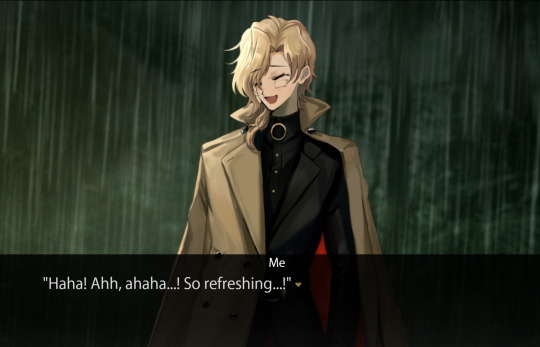
I couldn't come up with a better title for this section ¯\_(ツ)_/¯

One thing that is repeated in EX is that Natsume has the "disposition of a king." This likely refers to him having the disposition of a god (God in MAMIYA is referred to as "Our Lord," which in Japanese was 「我が王」— literally "Our King"), but it also allows us to draw parallels between Natsume and King Shahryar.
After discovering multiple instances of women cheating on their husbands (including his own wife), Shahryar ends up despising all women, condemning an entire gender because of a few women's actions. Thus he ends up in a cycle of marrying new brides and killing them the morning after. He detests women, and yet he needs them, keeps marrying them. Now, whether this was for physical reasons or because of "every king needs a queen" reasons or something else, I am unsure, but it is clear that his harmful views on women are responsible for a lot of death and destruction. As the story goes, Shahryar's kingdom, which had previously flourished for 20 years under his just rule, quickly becomes grief-stricken and desolate as families either lose their daughters or leave town.
This closely resembles Natsume's actions in EX: He's so addicted to chasing after Mamiya, to hunting him down at every turn that he can't be stopped or reasoned with. He kills Nidome before Nidome has a chance to report him, and when Natsume reaches his breaking point and decides that the only way to ensure he's destroyed all the fingerprints Mamiya left in the books is to destroy all books, he burns down the entire library, killing untold numbers of Spectators, Librarians, and stories. Like King Shahryar, Natsume's understandable anger against a single person morphs into violent, uncontrollable, indiscriminate destruction.
That "single person" is in Natsume's case, of course, the first Mamiya, the one who had managed to obtain a body. If the storyteller Mamiya is Scheherazade and all the murdered fingerprints are the unlucky brides, then that original Mamiya is Shahryar's first wife. It is this Mamiya who spurs Natsume to begin his killing spree of the fingerprints—the other virgins "brides." It is this Mamiya who causes Natsume's transformation from a gentle person into a veritable monster. It is this Mamiya who haunts the narrative, the driving force behind Natsume's actions throughout EX.
The primary difference between the two scenarios, however, is that unlike Shahryar's first wife, Mamiya spurring Natsume into his destructive spiral was entirely deliberate. The original Mamiya intentionally told Natsume all about the fingerprints in order to ensure Natsume would continue chasing after him; Mamiya says as much just before he changes clothes and heads over to the burning church.

Mamiya revealing the existence of the fingerprints and Natsume's wish to continue killing Mamiya drive Natsume to live for the hunt. Natsume hates Mamiya, and yet he needs him, just as Shahryar needed his women.
Last similarity between Shahryar and Natsume I wanna mention: their favored methods of killing their "brides" (decapitation via sword for Shahryar and bare-handed strangulation for Natsume) both involve neck trauma. I can't really connect this to anything, but Nima told me to mention it anyway. Um, Shahryar orders his subordinates to behead his brides, so there's an element of distance as opposed to Natsume, who purposefully eliminates all distance and is perfectly willing (and eager) to dirty his hands. So I guess Natsume is a hands-on kind of ruler? hahahaha
Telling Stories About Storytelling
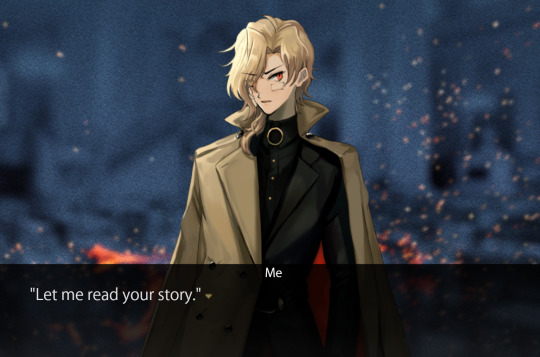
Natsume about to read his least favorite book, MAMIYA.
Now that we've talked about the characters, I want to talk about the story! Just like MAMIYA A Shared Illusion of the World's End, 1001 Nights is presented as a story within a story. Or, rather, they are both presented as multiple stories within a story.
The way that Natsume and Mamiya jump into different books and stories together also parallels, to some degree, how Scheherazade told her husband a new story every night. Through her stories, she too whisked the king away from their desert home to wonderful and fantastic worlds. I suppose the desert as a setting in EX was primarily chosen because of the "Was there love out in the desert?" poem, but it does tie nicely into Arabia as Natsume and Mamiya's "home base." It's kind of the place where they can be themselves— in the absence of everything else, they're able to present their truest selves.
One of the core themes that 1001 Nights shares with MAMIYA EX in specific is storytelling as salvation. King Shahryar and Natsume initially allow Scheherazade/Mamiya to live solely because of their ability to recite stories.

Natsume about to read his favorite book, MAMIYA.
A key difference, however, is that while Scheherazade recites a new story each night, Mamiya retells the same one every time. He's stuck reading from the same book. Unlike Shahryar, who is enthralled by each new story his wife tells and is excited to hear what she'll say next, Natsume specifically keeps Mamiya as a means of revisiting happier days that they can never return to. King Shahryar returns to his formerly gentle and just disposition by listening to Scheherazade's stories, which generally are all infused with a moral lesson that Shahryar (and the audience) can take to heart. On the other hand, dwelling on the past is shown to be unhealthy for both Natsume and Mamiya, and it ultimately leads to them trying to kill each other. In their case, while Mamiya's storytelling serves as a type of salvation to Natsume, Natsume's insistence on clinging to the past ensures that it is ultimately only a temporary stopgap as his body continues to deteriorate.
Hm, now that I think about it, the first Mamiya only dies after regaling his own tale to Natsume. This original Mamiya could, possibly, be considered a failed Scheherazade— in an alternate universe, if Scheherazade's stories hadn't pleased the king, she would have likely ended up killed just like all the other wives. Similarly, because Natsume decides that Mamiya's story means nothing to him (and there is something to be said about Natsume not caring about Mamiya's story, only his own), he ends up killing the first Mamiya.
Btw, the church scene is the last time anyone else says Natsume's name ("Read my story, Natsume") (The last time Natsume's name is said in game at all is in Mamiya's flashback of him waking up as a Spectator and saying, "I'm Natsume. Is this the afterlife?"), implying that, in a way, his name died with that original Mamiya. Depressing.
Anyway, let's wrap this up.
Ending on the 1001th Night
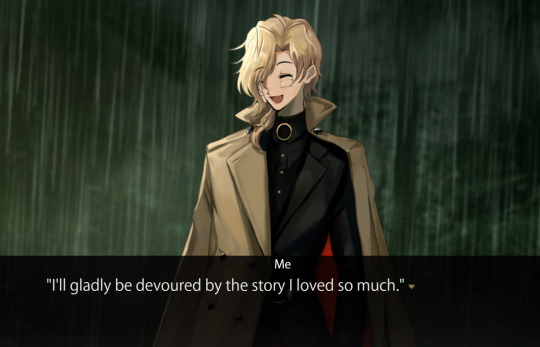
Vore as a metaphor for love, etc.; also, me experiencing MAMIYA: A Shared Illusion of the World's End.
This is a little more tenuous, but the endings of EX might also be parallels to 1001 Nights. At the end of the 1001 Nights, despite her having run out of stories, Shahryar understands that has fallen in love with Scheherazade and decides not to kill her, and they live happily ever after. At the end of EX, there's a moment where Natsume is in pain and Mamiya decides not to be "a machine that put out consoling words"—that is to say, he gives up on telling Natsume a story, ending his "1000 tales."
Once those "1001 nights" are over, Natsume has three options: Kill Mamiya, let himself be killed by Mamiya, or neither.
The worst outcome seems to be the first one: If Natsume decides that Mamiya should die, then Mamiya declares that Natsume will never find love. Afterwards, Natsume notes that 'fantasy' died and vanished from the world. If we're tracking the Scheherazade metaphor, this would be like if the king had her executed after all. If he had killed her, he would have killed off the source of all those fantastical stories, and he would have never found love or his happily ever after—Shahryar would certainly have instead taken another virgin and executed her the next day, continuing his cycle. Killing off Mamiya really does mean that Natsume will never find love again.
The endings where Natsume spares Mamiya are more positive. If Natsume allows himself to be killed by Mamiya, who he sees as "love" itself, then Mamiya is happy to eat him. Afterwards, Mamiya cheerfully decides he'll write a story of his own, which is fitting—with Natsume gone, he is finally able to move on from the one story and create something new, something all his own. This would be if Scheherazade was able to leave the king (or killed the king???); she'd probably be fine out there. Likely, as such a well-learned woman, she'd be able to find her own love and success in the future.
And if Natsume decides that neither of them are "love," they both live, and continue traveling together. I guess it's not quite "happily ever after" as it's quite ambiguous where they go from there, but they seem to have reconciled.
More importantly, they have a conversation about love.

Surely King Shahryar hadn't been expecting to find love with Scheherazade when he'd married her. He'd expected to kill her after that first morning, but through their time together, he fell in love. Natsume is similar. It's clear from Mamiya's last line, "What's truly important can't be seen, and what's dear has always been by your side," that the love Natsume speaks of... is Mamiya, even if Natsume doesn't realize it. That last line, where Mamiya summarizes and echoes Natsume's belief that "Love is something you won't find even if you look all over the world, but something that's in your hand before you even realize it," reflects Mamiya's existence itself; that is what Mamiya was for Keito and the pink house members, and likewise what Nastume was for his friends.

The dream of a mundane everyday life with his friends that Natsume has following this conversation explicitly includes Mamiya. Even as Natsume claims to have forgotten the contents of the dream, his subconscious recognizes and accepts Mamiya as a part of his narrative along with all the other people he loves. This is something deeply important, given how the overarching plot of DDD depicts Natsume loving and accepting Mamiya as synonymous with Natsume loving and accepting himself, as well as in the context of parallels with Shahryar and Scheherazade.
Anyway, that's all of the similarities I (and my co-collaborator Nima) found between MAMIYA EX and 1001 Nights! I'm surprised by how long it took me to notice these, considering how blatantly EX spells it out...
In conclusion:
Natsume and Mamiya marriage real
MAMIYA EX mirrors the tale of 1001 Nights through its focus on storytelling as a form of salvation, inserting Mamiya into the role of the captive storyteller Scheherazade and Natsume into the role of the vengeful King Shahryar. Which means they are metaphorically mar—

Thanks Nima for co-collaborating and peer reviewing (as a fellow natsumiya brainrot patient), and for general help with bouncing ideas. Couldn't have done it without you!! Remember when we spent an hour trying to figure out if "the king decapitated his daughter" was supposed to be a reference to one of the one thousand tales? Haha good times
This analysis hits all the major points, but there's probably a lot of less obvious stuff we missed. Like, there's a part where Natsume says, "Since the moment I 'became king,' I was turned into a a part of Our Lord's story," and that feels pertinent, but this thing was getting too long, so I decided not to look into it much. Also, since this is laser-focused on EX, there might be parallels in the main story that I missed...
Let me know what you think! I always like hearing other people's analysis. I don't usually do this kind of stuff but as I noticed more and more similarities between EX and 1001 Nights I got kind of excited. Send me an ask, DM me, or join the MAMIYA Discord!!
27 notes
·
View notes
Note
I played Kaveh's Hangout and I'm being haunted by him now 💀
Anyways I want to write Kirara but I already know I'll focus on her being a nekomata more than anything else xd
Also Comrade um.
I'm not being rude I hope but could you please tell me what some of the things in Sumeru are based off? I really want to know more :D
Kaveh's hangout was SO good one of the few hangouts that didn't bore me and it was better than even some of the story quests <3
You aren't being rude at all! There are so many things I don't know where to start lmao but the biggest thing I can think of is that Sumeru being a nation full of scholars is a reference to the islamic golden age where scholars would come to baghdad to seek knowledge.
Oh the topic of Kaveh, he is inspired by Kaveh the Blacksmith who is a famous persian (and kurdish) mythological character and is a symbol of resistance and unity against despotic foreign rulers in Iran. All of Kaveh's architecture designs (especially palace of alcazarzaray) have strong elements of persian architecture, and it's the same for the designs on his attacks! His constellations are also named after historical monuments is iran :3
Faruzan (whose name is inspired by the femine Foruzan and the masculine Farzan), there's also the term Firouzeh which is this beautiful turquoise that is seen in her character design color.

Her idle animations are a reference to the Persian Polymath Muhammad ibn Musa al-Khwarizmi, also known as the father of algebra. In her idle animation, when she's thinking if you decrypt it, this is what you'll get! All of it is a reference to "kitab al jabr and muqabla" written by Muhammad ibn Musa al-Khwarizmi himself.

And the dress she's wearing is a reference to persian architecture such as these, and the last picture is from a place called Shah Cheghrah, while her skirt style and shoes are from the Qajar period.

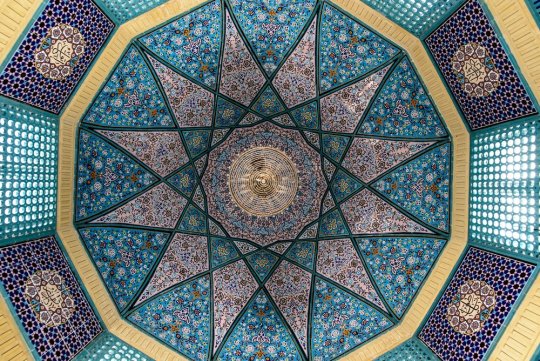
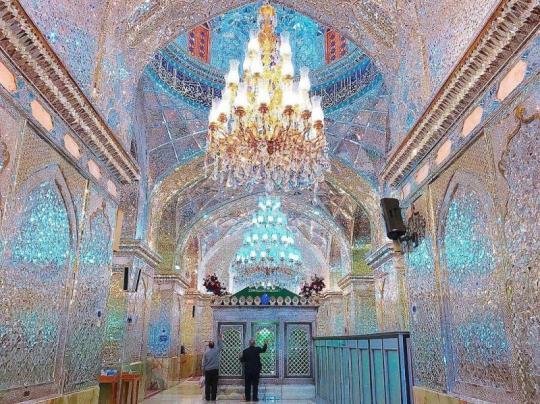
After her we have the man himself, Al-Haitham! He is inspired by the great iraqi mathematician, astronomer, and physicist Hasan ibn Al-Haytham from the Golden Age of Islam, and is also widely known as the father of optics!
Remember in the Archon quest when Alhaitham had to fake insanity? It's actually similar to something that happened to Hasan ibn Al-Haytham! He was invited by the cruel ruler Al-Hakim (later known as the Mad Caliph, I believe) to Egypt with a scheme to control the waters of the Nile, which is an impossible feat to do.
Although he failed to do what al-Hakim asked him to, he was still rewarded with an official government post. The more al-Hakim became more erratic, Ibn al-Haytham believed that his life would be in danger so he feigned madness to be relieved of his post!
Now on to al-Haitham's design. He has a few eye shaped deigns across his clothes which are again a reference to Ibn al-Haytham's study on optics. And his burst animation is showing light refelcting from mirrors, a reference to ibn Al-Haytham's research in light. His shoes are called babouche and worn by both men and women! Also, his name Alhaitham means "hawk", an animal that is seen as powerful figures in arabian cultures since they represents vitality and heroism, and the hawk is seen in his constellation!
Chinvat Ravine is persian and references Zoroastrianism, Ashavan Realm is sanskrit and means something along the lines of "forest with life", Ghanda Vil is a reference to hinduism and is inspired by Gandhamardan Hills located in India and is known for medicinal plants.
Mt. Damavand is a real mountain and it's considered the highest peak in Iran and Western Asia, and it's also important in folklore and mythology because it was the mythical place that was a prison to the three headed, three jawed and six eyed dragon Azhi Dahak.
A place inside the robot in the newest desert region is called Madinat-Al-Nuhas which is a reference to the Arabian the folktale city of brass!
Gate of Zulqarnain means gate of the two horned in arabic, and it's a reference to Dhu al-Qarnain who was a righteous king that travels to east and west and sets up a barrier between a certain people and Yajuj and Majuj (remember Wadi-al Majuj on the map? 😉).
House of Daena is a reference to the Grand Library of Baghdad, and Port Ormos refers to Port Hormuz that is set up on the Persian Gulf!
There are way too many are names but all of them are reference to religions/and languages!
Areas aside, the Dance of Sebzorous is based on the Iranian(and kurdish etc) New Year celebration called Newroz which celebrates the incoming of spring/life. And the dance that Nilou does is a Persian Court Dance! And her being thwarted by the Akademiya, thus "arts" being considered illegal and then her dancing in front of the Akademiya paint a picture of the current Iran where women dance in the streets in retaliation to the government. Nilou's ovarall character represents the struggles and oppression iranian women face from a government that seeks to discourage women pursuing arts and their passions.
Also remember Farris, the man who gave Yalda candies to children? He is inspired Amou Newroz (uncle Newroz) who gives candies to children. Yalda is also a term taken from the "night of Yalda" tradition which celebrated the longest night in winter (My family says 21/12 is Yalda night lol).
Moving on to the Khaverna of Good and Evil, Khvarena is a concept in Zoroastrianism and broadly emboies "glory" and "splendor". Pari is a term that quite literally means fairy in my language lolol. Anyways, Pari are originally creatures from Zoroastrianism. Originally, pari were considered as "witch" and "sorceress" but their role in mythology shifted completely in later times, and they were then considered was beautiful, feminine entities that are fundamentally good in nature.
Sorush (called so in New Persian) is a being of Yazata (divine being/creature) in Zoroastrianism and is one of the three guardians of Chinvat Ravine (bridge of judgement) along with Rashnu and Mihir. In Shahnameh, which is a collection of epic poems of Iranian mythology by the Persian poet Ferdowsi and retells man stories from Zoroastrian scripture, Sorush appears as a Pari (now benevolent creatures) to warn the Iranian king Siyamak about a calamity.
In the game, Sorush calls the Traveller Yasnapati. Yasna can be translated somewhat to "ritual", "sacrifice", and "worship". So Yasnapati in the Avestan language is "lord of ritual" which is a reference to the orginal scripture in which Sorush himself is callled "ritual lord". There are so many other things about the other Pari like Rashnu and Mihir and Zurvan but I think this has gotten pretty long enough 💀
But for funsies, Jar Jar is merely a reference to JarJar Binks from Star Wars lol.
Anyways, I hope this all helps! There are so many other things worth talking about, but I think this is enough for now lol
37 notes
·
View notes
Text
Obscure Animation Subject #90: 1001 Arabian Nights
A 1959 American animated feature that serves as one of the only two films produced by United Productions of America (UPA), the other being the more well-known Gay Purr-ee. It is directed by Disney director Jack Kinney from a script written by Dick Shaw, Dick Kinney, Leo Salkin, Pete Burness, Lew Keller, Ed Nofziger, Ted Allen, Margaret Schneider and Paul Schneider. It was distributed by Columbia Pictures as their first animated feature they distributed, and was released on December 1, 1959.
The film serves as a a loose adaptation of the Arab folktale of Aladdin from One Thousand and One Nights, albeit with the addition of UPA’s star cartoon character, Mr. Magoo, to the story as Aladdin's uncle, "Abdul Azziz Magoo".
The film was originally gonna be directed by Pete Burness, who was the series director on the popular series of Mr. Magoo theatrical cartoons produced for Columbia by UPA between 1949 and 1959. However, Burness resigned due to creative differences by producer and UPA owner Stephen Bosustow. Jack Kinney replaced Burness as director since Kinney had recently left the Disney studio at that time. The voice of Magoo in the cartoons, Jim Backus, reprises his role in the feature, with Katheryn Grant, the singer/actress wife of Bing Crosby, as the voice of Princess Yasminda and Dwayne Hickman, from TV's The Bob Cummings Show and The Many Loves of Dobie Gillis, as the voice of Aladdin.
UPA was already recognized at the time, since the studio, alongside WB director Chuck Jones, had revolutionized animation during the 1950s by incorporating design and limited animation. It also featured a voice cast of multiple stars voicing the characters, so how successful was it?
It was box-office bomb, due to competing with the highest-grossing film of the year, Ben-Hur. As a result, Columbia ended its distribution deal for UPA in favor of of lower-cost Loopy De Loop cartoons from Hanna-Barbera, a studio which Columbia had begun its deal with to distribute The Flintstones, the first animated series produced for prime-time. Following the film's release, Bousustow sold UPA to Henry G. Saperstein, who would own the studio with its animation assets dissolved and turning it into a film distribution company, before his death on June 24, 1998. UPA shuttered operations by the new millennium.
Today, this film is largely forgotten about and its not well known unlike UPA’s other animated feature, which got a cult following.

5 notes
·
View notes
Text

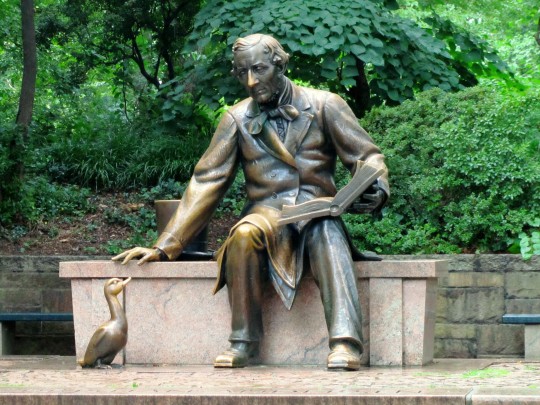

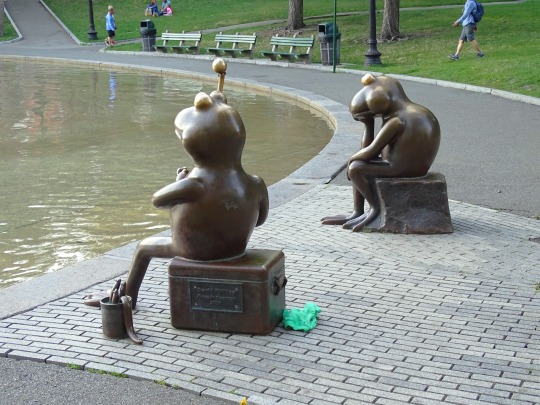



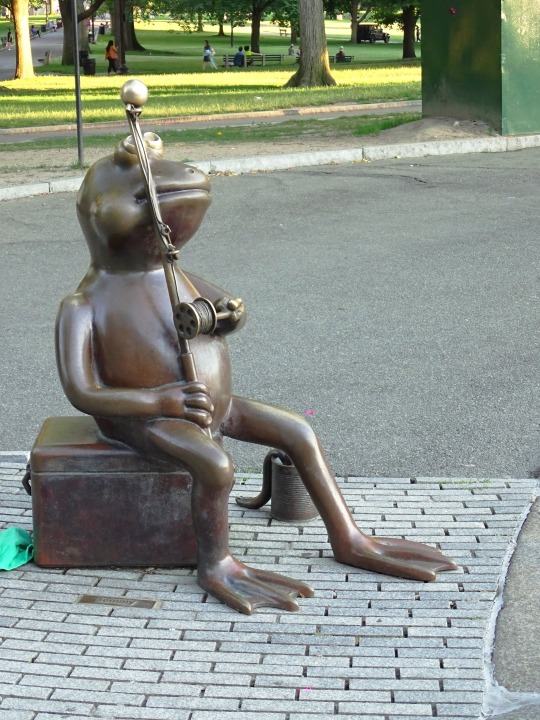






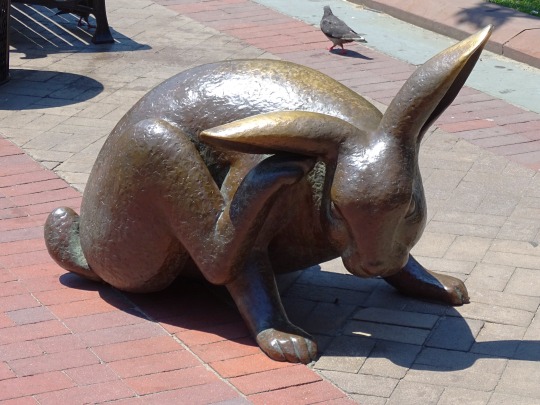
National Tell a Fairy Tale Day
Gather round the fire, and make yourselves comfortable… Tell A Fairy Tale Day is all about exploring myths and stories, old and new. From grim(m) tales to urban legends, tap the dark corners of your subconscious and see what you find…
History of Tell A Fairy Tale Day
The sharing of magical, otherworldly stories is a tale as old as time. While the term ‘fairy tale’ was coined in 1697 by Madame d’Aulnoy (conte de fées in her native French), it’s likely that some fairy tales originated as early as the bronze age over 6,000 years ago. And for most of history, fairy tales have been passed on not in written form but via the oral tradition, with each generation telling and dramatizing stories to the next.
The fairy tale’s ancient roots can be traced all over the world, from Vikram-Betaal in India and Aesop’s Fables in Ancient Greece to Arabian Nights in the Middle East. It was during the late 17th to 19th centuries that fairy tale collectors emerged, most famously Charles Perrault and the Brothers Grimm. While the Brothers Grimm aimed to preserve folktales in their pure form, documenting them in the way they were told by rural peasants unable to read or write, Perrault and others reworked fairy tales for literary and artistic effect, with some writers such as Hans Christian Andersen dreaming up their own new stories.
As the fairy tale’s history emerges into the modern day, it’s clear that the genre is still as popular as ever – look no further than the success of Disney movies to see how these stories continue to capture our hearts and imaginations. In fact, the famous Disney castle is inspired by Neuschwanstein Castle in Germany, built by none other than the Märchenkönig (fairy-tale king), Ludwig II of Bavaria, himself. Perched on a rocky hill and with horse-drawn carriage rides up to the front door, Neuschwanstein and its elaborate interior abound in myths and legends – the castle is even home to an artificial grotto!
By celebrating Tell A Fairy Tale Day, you’ll be continuing the magical tradition that has ensured fairy tales are still very much part of our lives to this day.
How fairy tales change over time
Perhaps one of the most interesting aspects of fairy tales is how they change over time. Simple plot structures, motifs and archetypal characters recurring across many cultures make these stories rife for adaptation and reinterpretation.
Although nowadays we usually associate fairy tales with children’s literature, you may be surprised to learn that many of today’s beloved stories have rather dark and disturbing origins. Imagine a world in which no woodcutter comes to save Little Red Riding Hood from the wolf’s belly, or in which one of the ugly stepsisters cuts off her own toes so that her foot fits in the slipper! From the 18th century onwards, many fairy tales were toned down and reworked so that they were more suitable for children.
These stories and the genre itself have also been adapted and reinvented for different time periods and cultures. Alongside original modern-day fairy tales, there are also various retellings, for example in urban settings or different countries. One particularly common type of retelling comes from women writers. Authors such as Angela Carter and Margaret Atwood have taken what are often seen as outdated tropes about women and reinvented them – the damsel in distress becomes the plucky heroine, and the trapped bride leaves her ogre husband for her happily ever after.
Why fairy tales are important
As it is often claimed Albert Einstein once said, “If you want your children to be intelligent, read them fairy tales. If you want them to be more intelligent, read them more fairy tales.” We might not expect such high praise for fairy tales from a world-famous theoretical physicist, but Einstein recognized the importance of the imagination. Fairy tales are incredibly valuable for both children and adults when it comes to learning about the world in which we live and developing our capacity for creativity. Fairy tales have also been considered fertile ground by psychoanalysts. With their twists and turns, age-old themes and familiar characters, our favorite stories may reveal not only the workings of our personal subconscious but also the fundamental elements of our collective psyche.
How to celebrate Tell A Fairy Tale Day
It should be clear by now that, when it comes to celebrating Tell A Fairy Tale Day, you really can let your imagination run wild! And while it’s a day that kids will love, it’s also a great occasion for adults too.
Gather your friends and family and take it in turns to share your favorite stories with one another. Time to brush up on your acting skills, as the more dramatic enactments the better – whether you’re good at impersonating a wicked witch or excel at acting out the characters’ quest through the enchanted forest, you’ll want to really make the tale come to life for your audience. And why not sit around a bonfire toasting marshmallows or string up some fairy lights in your living room to add to the atmosphere?
Alongside sharing the stories we know and love, fairy tales are the perfect genre for getting creative and honing your writing skills. Take a well-known story and tweak it to fit a different time or setting, or have a crack at inventing your own. It may well start with ‘Once upon a time’, but it’s completely up to you whether there’s a ‘Happily ever after’! Many libraries and literary organizations will also share stories and creative resources and even hold events to help mark the occasion.
If writing’s not your thing, then there are plenty of films and programs based on fairy tales for you to enjoy. Disney’s Snow White and the Seven Dwarves, Cinderella and The Little Mermaid are just some examples of the media giant’s adaptations, while movies and TV series such as Into the Woods and Tell Me a Story interweave and retell various classic fairy tales for new audiences.
And if you feel like going all out, why not host a fairy tale themed party? Encourage your guests to come in fancy dress, put on an enchanted feast of yummy snacks such as gingerbread houses and toadstool cupcakes, and throw some legendary party games like hunt the pea and castle building.
However you choose to celebrate Tell A Fairy Tale Day, it’s sure to be a magical occasion!
Source
#Hans Christian Andersen Statue by Georg John Lober#Central Park#Manhattan#Little Mermaid by Edvard Eriksen#New York City#Copenhagen#København#Denmark#summer 2006#public art#Den lille Havfrue#Tell a Fairy Tale Day#NationalTellAFairyTaleDay#26 February#Alice The Way Out by Liliana Porter#mosaic#MTA New York City Transit#Alice in Wonderland#Boston Common#Frogs at Tadpole Playground by David Phillips#Boston#original photography#travel#vacation#tourist attraction#landmark#USA#Tortoise and Hare by Nancy Schön
5 notes
·
View notes
Text
Me: The Disney!Aladdins, while highly entertaining, are yet another misrepresentation of Arab customs, clothes, settings and culture, as all of these were heavily influenced by South Asian clothes and aesthetics in both movies rather than strictly Arabian; and while the original folktale (which wasn’t even a part of the One Thousand and One Nights text originally) does mention "China" or sometimes "India" as its setting depending on the version, this expression is more used as a way to refer to a faraway land in general rather than the specific country and culture (exactly like saying "once upon a time, in a faraway land"). Proof being that whatever the setting is said to be (China or India), everything about the story remains Middle Eastern: the ruler is called a Sultan instead of an Emperor; the magical being in the story is a djinn (not any other being in Chinese folklore and mythology), the names themselves are Arabic (Aladdin = علاء الدين, ʻAlāʼ ud-Dīn/ ʻAlāʼ ad-Dīn), etc. Thus, Aladdin is inherently an Arab story (and probably Syrian in origin as the earliest recollection we seem to have comes from the Maronite storyteller Antun Yusuf Hanna Diyab, who was from Aleppo – or at least, he transmitted the most well known version); and bringing up the "Chinese or Indian" argument is misunderstanding the use of the expression as literal rather than metaphorical. Unfortunately, this is misrepresented in the Disney animated movie as well as its live action remake.
Also me: ARABIAN NIIIIIIIIIGHTS, LIKE ARABIAN DAAAAAAAAAYS, MORE OFTEN THAN NOT ARE HOTTER THAN HOT IN A LOT OF GOOD WAAAAAAAAAYS
16 notes
·
View notes
Text
In the previous ask I got about “folklorist VS literary studies”, right here, I wanted to include a metaphor to better explain - but I couldn’t find anything.
I think I got a comparison that could work, (I hope it will), and I will take the work of another fairytale blog (which if you haven’t guessed by my many reblogs of it, I encourage you to follow): @princesssarisa
Princesssarisa has been doing a “Sleeping Beauty Spring”, exploring the various movie adaptations of Sleeping Beauty. And by looking at these adaptations chronologically, they realized that despite coming from different eras, different cultures and different nations, the movies seem to have influenced or taken inspiration from one another. You can find this in two of their posts, one tying Faerie Tale Theater’s Sleeping Beauty and the Czech “How to wake a princess” (here) and one comparing the Cannon Movie Theater’s Sleeping Beauty to the 70s German version (here).
And this is a perfect metaphor what “literary” studies are trying to do now, in the modern field of university teaching and study.
To explain: we have several movies based on the same fairytale, “Sleeping Beauty”. Imagine that each movie is a fairytale, folkloric or literary in nature, and that the original fairytale is actually the “fairytale type” under which the various folktales and fairy narratives are classified.
The “folklorist” point of view had the idea that each movie exist in its own continuty, context and world, separate and isolated from the others. Each one exists as just an adaptation of the original story, without side-influence of any kind, and are just direct adaptations of the story. Which is a true and right thing to point out.
But what the literary studies bring is what is either an additional info, or a nuance to the discourse, elements that the “folklorist” point of view tended to completely ignore (due to being a blindspot): maybe some movies actually take inspiration from other movies that adapted the fairytale? Maybe there are some side-influence, and one movie will include reference or have similar elements taken from a previous cinematographic adaptation. Maybe it is not just all from just the original fairytale and the movie-maker’s personal ideas, maybe each movie shoudn’t be seen as a sngular piece completely isolated and cut-off from other cinematographic works of the tale.
Because this is what literary studies are trying to bring, and where they oppose folklorist studies. It isn’t about negating the existence of folklore, denying the utility of folkloric studies or saying that literary fairytales should be the only fairytales existing... But it is about considering that maybe not all versions are like the roots coming out of a same tree, each individual and from a common source. Maybe the “movies” have more in common than just “being inspired by the same tale”. It is about considering the history and evolution of fairytales not as an hydra growing more head, but more as a chain of narratives spawning out of each other, as a game of “Chinese whispers” (we call it “Arabian phone” in France) where previous versions of the tale influence and shape younger ones. And the “literary studies” are called as such because, in this point of view, the typical “point of view” of fairytales as a whole is flipped.
Because in folklorist-sided texts, the folktales version of fairytales, the oral versions, the “collected” tales have always the authority and the primary importance - folklorist-sided experts tend to believe that literary versions of fairytales are just like movie versions of fairytales, sort of unique “aside” to the history of the tale with no actual importance in the greater scope, knock-offs that ultimately cannot change or even touch the “core narrative” of the folktale. It is a whole logic fed on the idea that “lower class culture, oral culture, uneducated culture is always more primitive and more raw than literary, upper-class, educated culture”. This is why this side of the fairytale study tend to search for the “truth” in these folktales - by being folktales, they are deemed “primitive” and thus somehow reveal a primal, primary truth that predates literary fairytales.
The literary studies reverse this by considering that maybe literary fairytales did have an influence over folktales, that maybe literary works did end up changing or starting oral tales, by the virtue of said literary versions being much more widespread, studied and “popular” than folktales (as in, when a literary fairytale becomes so well-known and so published it becomes part of a country’s literature classics, part of a country’s popular culture and common references known by everybody, maybe it should be given more credit over how it influenced the perception of the tale as a whole).
Mind you, the literary vs folklorist debate is still a debate. Not everybody agrees with the recent change in study-method and historical point of view that happened, and many still stick with what was the recognized, respected and adored model of the 20th century. But I want to insist that, while I am on the literary side of the debate, I also strongly respect (and sometimes use myself) “folklorist-sided material”, precisely because the two are complementary and one cannot completely ignore the other. Heck, folklorist studies are what saved fairytales in France from losing their place as a prominent part of the country’s culture (well, this is more the psychoanalytic point of view of fairytale study, but given they are influenced by folklorists points of view, I’ll still credit them for that)
#fairy tales#sorry for hijacking your blog and your posts X)#but you were the perfect example#fairytales#folklorist vs literary#history of fairytales#study of fairytales#i hope this clarifies my pov#and if it doesn't then it is official I don't know how to write anything#though metaphors were never my strong point
7 notes
·
View notes